In western Romania, between the city of Cluj and the town of Ciucea, is an area of gentle hills and winding roads, of sunflowers and storks, quaint villages and ancient churches. Called Calata in Romanian, it’s known as Kalotaszeg to the ethnic Hungarians who form the majority of the population, and who continue to practice age-old handicrafts and 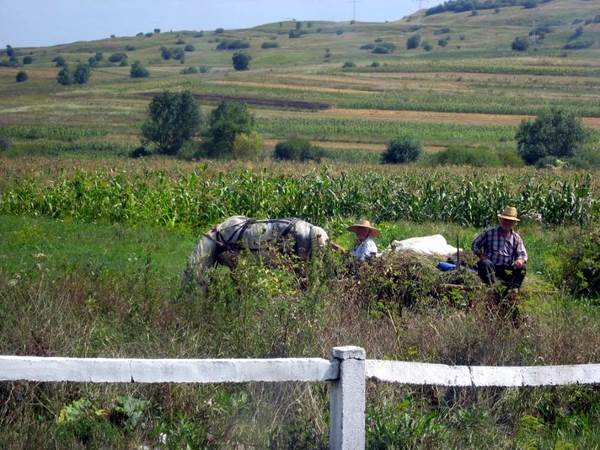 customs. Agri-tourism thrives here, with many villagers renting out rooms in their homes, while others advertise with the German words “Zimmer frei” (room free).
customs. Agri-tourism thrives here, with many villagers renting out rooms in their homes, while others advertise with the German words “Zimmer frei” (room free).
The people are friendly and unhurried, happy to exchange a “jo napot kivanok” (good day) with a passer-by. You’ll spot some interesting headgear, with women toting headscarves or broad straw hats while men wear tweed trilbys (black felt hats) or porkpies. Considering the unforgiving sun that beats down in summer, head protection is wise.
A lot of houses are decoratively hewn from wood, and filled with embroidered drapery and pillows, stoves covered with carved tiles, and red-painted furniture with floral motifs. In an incongruous modern touch, some homes have satellite dishes, picking up TV stations from Hungary.
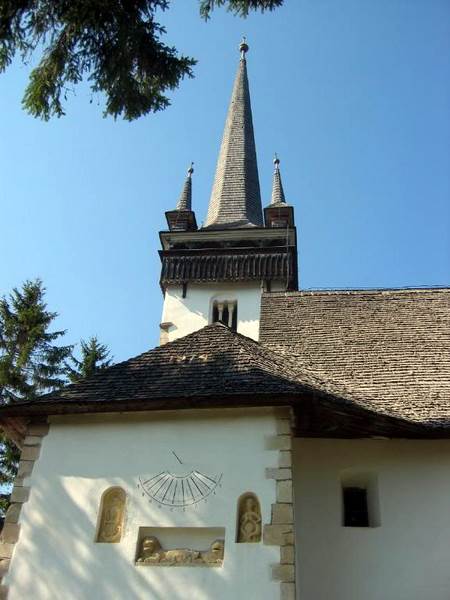 Quaint villages hold beautiful old churches, with whitewashed outer walls but colorful decorations inside. If a church is closed, ask around the village for the priest – “preot” in Romanian or “pap” in Hungarian – who will let you in. The churches, originally Catholic, now mostly serve the Calvinist denomination, to which many Transylvanian Hungarians converted in the 16th and 17th centuries.
Quaint villages hold beautiful old churches, with whitewashed outer walls but colorful decorations inside. If a church is closed, ask around the village for the priest – “preot” in Romanian or “pap” in Hungarian – who will let you in. The churches, originally Catholic, now mostly serve the Calvinist denomination, to which many Transylvanian Hungarians converted in the 16th and 17th centuries.
The main town is Huedin (Banffyhunyad in Hungarian), home to about 10,000 people. It is built around a main road, lined with shops selling car parts, household appliances and hardware, with a great deal of through auto traffic thundering along. Huedin’s church, founded in the 13th century, has much in common with others in the area. Its interior walls are festooned with cloths decorated with red and blue embroidery that depicts traditional motifs or spells out heart-warming rhymes. A cloth like this is known in Hungarian as “falvedo” (wall-protector.) You’ll see another typical feature if you look up from the wooden pews and study the church’s slightly warped 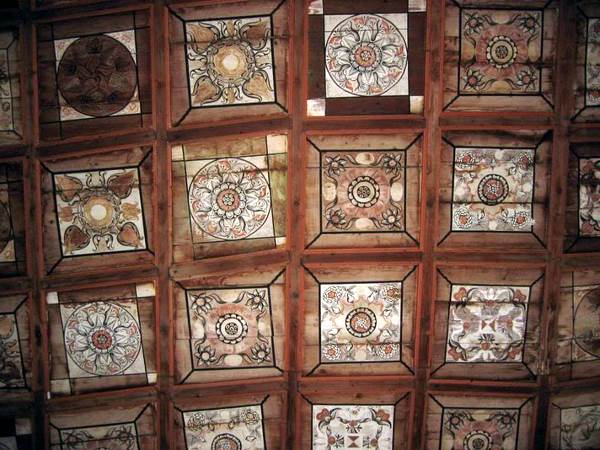 ceiling. The ceiling is covered with a patchwork of wood panels (“cassettes”) painted with religious or folkloric designs and sayings. These were added to the area’s churches in the 18th century. Another 18th century touch found here, and in other churches, is the carved pulpit, topped by a sculpted pelican. This bird was used to symbolize Jesus, because of its mythical habit of nourishing its chicks with its own blood. If the church is closed, you can find the priest at number 28 on the side street that runs by it.
ceiling. The ceiling is covered with a patchwork of wood panels (“cassettes”) painted with religious or folkloric designs and sayings. These were added to the area’s churches in the 18th century. Another 18th century touch found here, and in other churches, is the carved pulpit, topped by a sculpted pelican. This bird was used to symbolize Jesus, because of its mythical habit of nourishing its chicks with its own blood. If the church is closed, you can find the priest at number 28 on the side street that runs by it.
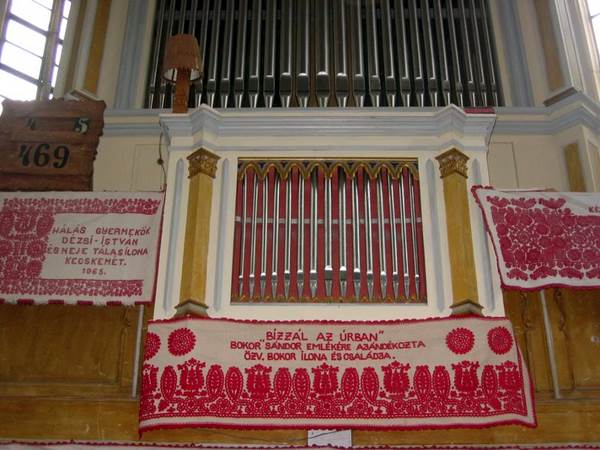 Next to the church stands a tower, which was already here by 1411. It formed part of what was originally an entire fortified surrounding wall, where Huedin residents took shelter during raids by Turks. Right opposite the church is the hulking concrete Complex Comercial Vladeasa, a block that contains a large restaurant named Montana. It has a covered terrace in front with log tables and benches and it is not a bad place to eat.
Next to the church stands a tower, which was already here by 1411. It formed part of what was originally an entire fortified surrounding wall, where Huedin residents took shelter during raids by Turks. Right opposite the church is the hulking concrete Complex Comercial Vladeasa, a block that contains a large restaurant named Montana. It has a covered terrace in front with log tables and benches and it is not a bad place to eat.
As for smaller localities in the area, one worth visiting is Sancraiu (Kalotaszentkiraly). It is also an agri-tourism center, with many residents offering rooms for tourists. A dance camp is held every August and has grown to become an international event. It is organized by Davincze Tours, which operates out of house 291 near the church. The village’s 13th century church proudly displays a ceiling covered with 200 panels.
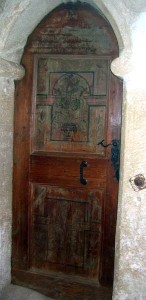 Another village, Vistea (Magyarvista), contains a church on a little hill in its center. It’s approached by entering a gate and climbing a spiraling path framed by stone walls, into which gravestones are set at intervals. Founded in 1280, the church was renovated several times in subsequent centuries but retains many original features. In a throwback to the days when Christianity was something to which locals had to be introduced gently, you’ll spot some pre-Christian symbols – a moon, sun and stars – on the southern entrance. Other intriguing, old characteristics can be found inside. Frescos dating from earlier than 1580 were uncovered in 1913, having been designed and created in the days before the local population converted from Catholicism to Protestantism. Calvinist ideas about proper church decor required that
Another village, Vistea (Magyarvista), contains a church on a little hill in its center. It’s approached by entering a gate and climbing a spiraling path framed by stone walls, into which gravestones are set at intervals. Founded in 1280, the church was renovated several times in subsequent centuries but retains many original features. In a throwback to the days when Christianity was something to which locals had to be introduced gently, you’ll spot some pre-Christian symbols – a moon, sun and stars – on the southern entrance. Other intriguing, old characteristics can be found inside. Frescos dating from earlier than 1580 were uncovered in 1913, having been designed and created in the days before the local population converted from Catholicism to Protestantism. Calvinist ideas about proper church decor required that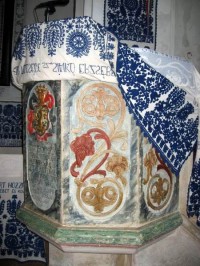 the frescos be covered up after the conversion. Incidentally, this was one of the first Reformed churches throughout Transylvania, having made the switch only a few years after Calvinism was established in the region. Unusually, the Vistea church’s bell tower is separate from the main building, and made of wood. The timber is said to have come from a now extinct forest which grew on a hill close by while the bell was forged in 1784. The priest lives next to the church, his house and yard separated from the church grounds by a simple gate.
the frescos be covered up after the conversion. Incidentally, this was one of the first Reformed churches throughout Transylvania, having made the switch only a few years after Calvinism was established in the region. Unusually, the Vistea church’s bell tower is separate from the main building, and made of wood. The timber is said to have come from a now extinct forest which grew on a hill close by while the bell was forged in 1784. The priest lives next to the church, his house and yard separated from the church grounds by a simple gate.
Many master masons operate in Vistea, with signs on their houses advertising their skills. It’s an industry for which the village’s inhabitants have had an excellent reputation for centuries.
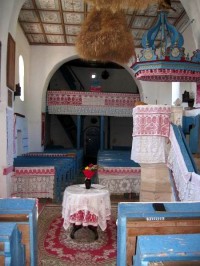 Other lovely village churches – displaying many of the same typical features – are in Valeni (Magyarvalko) and Manastireni (Magyareromonostor). And there is a particularly large one in Izvorul Crisului (Korosfo). It is surrounded by fortifications and stands on a hill. While it shares the cassette ceiling found in other churches in the area, it has one unique feature: a 1660 Turkish carpet. This was donated by Gyorgy Rakoczi II, prince of Transylvania, in gratitude to the villagers who nursed him after he was injured fighting Turk invaders. Izvorul Crisului is also a great shopping village. In fact, its entire main street is full of shops selling craft and art items. Some of these are tacky trinkets, identical from store to store. But look more closely and you will find some interesting handmade wall hangings and ceramics – charming pieces of Kalotaszeg to take home with you.
Other lovely village churches – displaying many of the same typical features – are in Valeni (Magyarvalko) and Manastireni (Magyareromonostor). And there is a particularly large one in Izvorul Crisului (Korosfo). It is surrounded by fortifications and stands on a hill. While it shares the cassette ceiling found in other churches in the area, it has one unique feature: a 1660 Turkish carpet. This was donated by Gyorgy Rakoczi II, prince of Transylvania, in gratitude to the villagers who nursed him after he was injured fighting Turk invaders. Izvorul Crisului is also a great shopping village. In fact, its entire main street is full of shops selling craft and art items. Some of these are tacky trinkets, identical from store to store. But look more closely and you will find some interesting handmade wall hangings and ceramics – charming pieces of Kalotaszeg to take home with you.


Comments